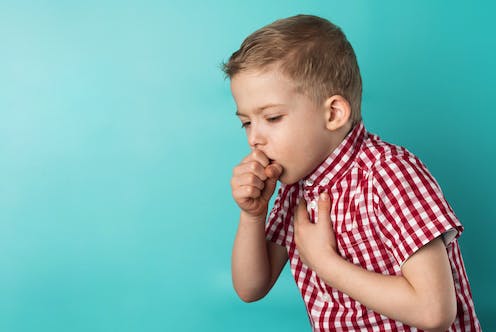
Zdan Ivan/Shutterstock
You may have read recent alarming reports of a cough that “lasts 100 days” is “quickly spreading across the UK” and can “fracture ribs”. If you didn’t look beyond the headlines, you might have missed the fact that the reports are about whooping cough.
So, what is going on?
Whooping cough (or pertussis) is what is known in the UK as a “notifiable infectious disease”, which means any doctor who diagnoses a case has a legal duty to report the infection to the local authority. Notifications of whooping cough are indeed much higher this year, particularly in the five months since July than at any time during the previous three years.
In the 21 weeks to November 27, there were 716 notifications compared with just 217 in the same period in 2022, 213 in 2021 and just 72 in 2020. That is more than a threefold rise this year compared with the previous year.
Like most respiratory infections, whooping cough was suppressed during the COVID years. Notifications for whooping cough this year are still markedly down on 2019 where there were 1,842 notifications over the same 21-week period.
What we are seeing now is a partial return to the pre-COVID situation and not an unprecedented surge in infections. (Although the reported cases represent only a fraction of all cases in the community.)
The fact that whooping cough notifications are still relatively low should not distract from the fact that infections in the 2010s were still much higher than in the previous decade. Since the mid-1950s and the introduction of a vaccine, whooping cough was generally in decline until this most recent decade.
Table of Contents
What is whooping cough?
Whooping cough is a chest infection caused by the bacterium Bordetella pertussis – although another bacterium Bordetella parapertussis can also cause it.
The illness lasts for about six weeks or more and progresses through three stages. The first stage is very similar to a bad cold with a runny nose, sneezing and sore eyes.
The second phase, which starts after about two weeks, is characterised by bouts of intense coughing. Each bout can last several minutes and is occasionally followed by the loud whoop that gives the disease its name. Afterwards, a chronic cough can remain for several weeks.
Most people eventually make a full recovery, but in babies under three months old 1% to 3% may die. And most children under six months will require hospitalisation.
About one in 50 babies under one year will suffer convulsions and one in 150 (0.6%) will have encephalopathy (swelling of the brain).
Other even more serious neurological problems, such as paralysis and blindness, have been reported but are rare. In older children and adults, fainting, rib fractures, pneumonia and urinary incontinence can occur.
Antibiotics have limited value in treating whooping cough. They can reduce the time that the patient is infectious to others, but they have limited effect on preventing symptoms.
How to avoid getting it
There is an effective vaccine for whooping cough that in the UK is given in combination with other vaccines at eight, 12 and 16 weeks old. Then there is a booster shot given when the child is three years and four months.
The vaccine is also now recommended for pregnant women. This is not to protect the mother but to protect their baby during the first weeks of the child’s life before the first course of vaccine – when the infant would be at the highest risk of death.
Concerns about the safety of the vaccine, particularly during the 1970s, led to a significant fall in vaccine coverage and a re-emergence of whooping cough.
A committee of the US Institute of Medicine concluded that the evidence was “consistent with a causal relationship” between the vaccine and acute encephalopathy, with a risk estimated at between zero and ten cases per million jabs administered.
However, subsequent studies suggested that many of the cases in the biggest study had a particular genetic abnormality known as Dravet syndrome and the whooping cough vaccine was merely bringing forward the date of onset of problems that would have happened anyway.
In any event, the studies reported above were of a time when whole-cell vaccines were being used (made from killed whole bacteria). Since 2004, whooping cough vaccines made with just parts of the bacterium (so-called acellular vaccine) have been used in the UK and these are associated with a lower risk of side-effects.
Far from clear
The recent increase in notifications of whooping cough, as mentioned above, is due to COVID suppression measures – lockdowns, mask-wearing and hand hygiene – coming to an end. But why there were more whooping cough cases during the years 2010 to 2019 compared with the previous decade is far from clear.
Vaccine coverage in the years before COVID up to 2019 was no lower than ten years previously. Possible explanations include waning immunity, greater awareness of whooping cough among doctors (so more diagnoses), and improved laboratory diagnosis.
My take on the evidence is that the increasing infections in the years before COVID was down to the shift from whole-cell to acellular vaccine. Although the acellular vaccines cause fewer side-effects, they also generate less powerful immunity.
While both vaccines are highly effective at preventing severe disease, the acellular vaccine does not prevent mild infections that can be infectious for others for as long, so allowing the infection to continue to spread in the community.
The whole-cell pertussis vaccines were able to achieve herd immunity, which the acellular ones probably cannot. So the chance that young babies come into contact with an infectious older child or adult is now greater.
With the falling vaccination coverage in pregnant women this puts babies at risk in their most vulnerable first weeks of life.
![]()
Paul Hunter consults for the World Health Organization. He receives funding from National Institute for Health Research and has received funding from the World Health Organization and the European Regional Development Fund.



























